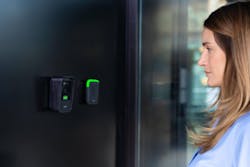Unlocking the Future: The Evolution of Building Access
Not long ago, unlocking doors with just a glance belonged to the realm of science fiction. Films like Minority Report and Blade Runner painted a world where biometric authentication was an everyday convenience rather than a distant dream. Today, that vision is no longer fiction but a sophisticated and secure reality. Facial recognition technology has evolved from a pioneering concept into an advanced authentication tool that’s transforming industries worldwide.
The way we access buildings has undergone a dramatic evolution. For much of modern history, wooden and later metal keys were the primary method of securing and unlocking doors. While effective, keys presented challenges, from being easily lost or stolen to requiring expensive manual distribution and replacement. The introduction of keycards and PIN codes over the last few decades began a shift towards digital access, improving security but still carrying risks such as credential sharing and unauthorized duplication.
Today, access control has reached new heights with smart, touchless solutions. Mobile credentials, biometric authentication, and cloud-based access management have made building security more seamless and adaptable. Facial recognition is at the forefront of this transformation, offering a frictionless experience while enhancing security. No longer do users need to fumble for cards or remember complex codes—modern systems verify identity in real time, granting access with unparalleled efficiency and accuracy.
Taking Things at Face Value
What was once seen as a futuristic convenience has now become an integral part of various industries. Facial recognition technology extends far beyond access control, seamlessly integrating into everyday life:
- Finance: Banks use facial verification for secure transactions and fraud prevention.
- Healthcare: Hospitals implement it for patient identification and streamlined record access.
- Air Travel: Airlines speed up boarding with biometric authentication.
- Retail: Stores personalize shopping experiences using facial recognition analytics.
- Mobile Security: Smartphones use facial recognition for secure and effortless authentication.
These applications highlight how facial recognition makes security almost invisible to the end user, blending convenience with high-level protection.
The Science of Biometric Authentication
What makes facial recognition uniquely powerful is its biological foundation. The human face has approximately 80 nodal points—distinctive markers that form a unique facial signature. These nodal points create patterns as intricate as a constellation in the night sky, an elegant metaphor for Salto’s latest innovation in access control.
Orion: A New Standard in Secure Access
Just as the constellation Orion has guided travelers for centuries, Salto’s Orion system leverages the distinct patterns of human facial features to guide users seamlessly through secure access points. This system represents the pinnacle of face recognition solutions in access control, combining:
- Sub-second response times for seamless user experience
- Advanced liveness detection to prevent spoofing
- High-precision biometric scanning to authenticate individuals with unmatched accuracy
Orion isn’t just about recognizing faces—it’s about redefining security by making it intuitive, reliable, and effortless. It processes intricate facial data, from the distance between eyes to the depth of cheekbones, illustrating the sophisticated interplay of hardware and software that powers modern biometrics.
The Future of Identity Verification
As artificial intelligence and machine learning continue to refine facial recognition tech, the possibilities expand beyond physical security. The future envisions a world where our faces serve as universal keys—not just to buildings and doors, but to personalized experiences, seamless transactions, and even smart environments that adapt to our presence.
The implications are profound. Just as celestial constellations have guided humanity for centuries, our facial constellations may guide us into a future where identity authentication is frictionless, security is uncompromised, and the boundary between physical and digital access disappears entirely.
Looking Beyond the Stars
The evolution of building access reminds us that what once seemed like science fiction is now a daily reality. As we push the boundaries of what’s possible, the goal isn’t just greater security—it’s creating intuitive, human-centered experiences that enhance rather than complicate our lives.
Ultimately, the magic of face recognition lies not just in its technological sophistication, but in its ability to make complex security feel natural and effortless. As innovation continues to align, the future of authentication isn’t written in the stars—it’s imprinted in the unique facial features that make each of us who we are.




